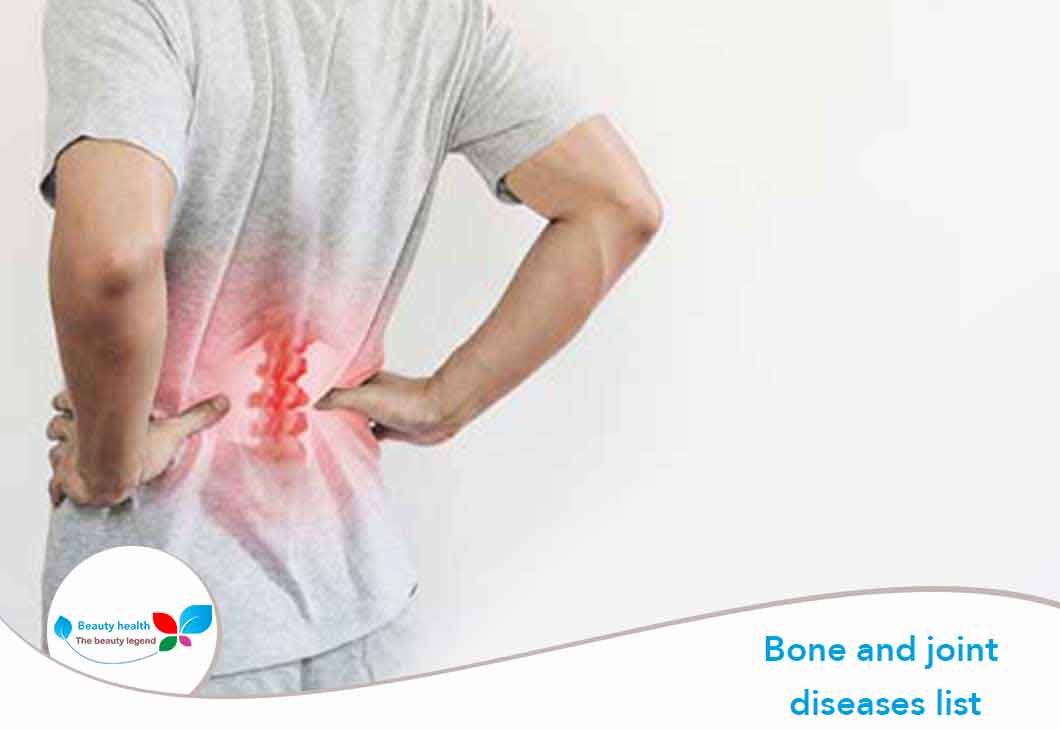Bone and joint diseases list
Bone and joint diseases list:
Bone and joint diseases list are the most important bone diseases, and what are hereditary bone diseases? How does osteoarthritis occur? What are the causes of joint pain? When is bone pain dangerous? What is the bone virus? What is orthopedic and joint surgery? How much does this surgery cost? And what is its success rate? Let’s get to know this information in today’s article from Health and Beauty website .
The most important Bone and joint diseases list:
Bone and joint diseases list vary and affect both the old and the young, so let’s get acquainted with the most common Bone and joint diseases list:
Osteoporosis (Bone and joint diseases list):
Osteoporosis affects both men and women and has multiple causes:
- It is a common condition among elderly men and women and is caused by lack of exercise, aging and a lack of estrogen in the fat.
- But due to the manufacture of estrogen in fats, it affects the thinnest, as the bones become thin and there is a lack of organic scaffolding that contains calcium .
- Female patients can also be treated with estrogen, and both sexes are advised to exercise load-bearing exercises such as walking and running
- But this is not often possible and those who suffer from spinal deformity and an increased risk of fractures, and pain
Rickets (Bone and joint diseases list):
Rickets is one of the genetic diseases that affect the bones:
- It is a form of hypophosphatemia, a hereditary form, as it is found in children.
- Caused by excessive kidney secretion of phosphate, researchers have found that indomethacin, a widely used pain reliever, prevents phosphate loss.
Osteoarthritis of the spine (Bone and joint diseases list):
From orthopedic problems osteoporosis of the spine:
- It is a common condition in the elderly and is the most common reason for hip and knee replacement.
- It also causes painful swelling in the fingers, which is more common in women
- The first indication of the disease is the gradual loss of large molecules called proteoglycans from the surface of the joint cartilage.
- This leads to a decrease in mechanical strength, and at the same time, other cells multiply and form clusters.
- Then cracks develop in the cartilage gradually” and the cracks are filled with fibrous tissue, perhaps as a result of failed attempts by the cartilage cells to repair the cracks.
- Finally, skeletons, called osteophytes, are formed around the joint, and the end result is the loss of joint function.
- Although the causes of osteoarthritis vary, mutations in two types of collagen are associated with early osteoarthritis.
- Research has shown that turning off a single gene can prevent the destruction of cartilage in humans.
- During human disease, the cartilage in the joints gradually breaks down and a major component of cartilage is chewed, which helps the tissues to bear the load and resist compression.
Arthritis disease (Bone and joint diseases list):
Inflammatory joint diseases include:
- Rheumatoid arthritis.
- Ankylosing spondylitis.
- Sjogren’s syndrome and lupus.
There are some common features and treatments for all these cases. With the exception of ankylosing spondylitis, women are affected more than men.
Often the skin and other organs are affected, and it is now understood that the conditions are caused by autoimmunity – that is, the body attacks itself.
All of these conditions have a genetic component:
- Both types of immune cells, called B and T cells, are involved in the attack on oneself that constitutes an autoimmune response.
- As these elements are necessary to fight infection, it is difficult to inhibit them without harm.
- T cells are immune white blood cells that attack joints and can be suppressed with a toxic drug called doxorubicin. This drug only targets T cells that attack joints.
Rheumatoid arthritis (Bone and joint diseases list):
Of the diseases of the bones and joints that affect the joints:
- As a result of the study and research, it was noted that people who suffer from rheumatoid arthritis have excessive amounts of an enzyme called senoviolin.
- While people with lower amounts did not suffer from rheumatoid arthritis.
- A drug has also been designed to reverse the action of the enzyme, thus reducing joint damage in half and reducing the amount of inflammation by more than 70%.
Spondyloarthritis :
Of the diseases of the bones and joints that affect the vertebrae:
- Ankylosing spondylitis is an inflammatory disease that affects the tendons that connect the vertebrae together.
- The inflammation gradually increases and the spine collapses, causing deformity.
- Patients often suffer from additional arthritis in the arms and legs, and they have diseases in other organ systems.
- Also, this disease is hereditary, but it is often caused by an infection, and the one responsible for the disease is a defect in a gene that causes a deficiency of a chemical, pyrophosphate in the joints
Lupus (Bone and joint diseases list):
Lupus is a disease of the bones and joints that affects the blood vessels:
- Lupus affects the skin, joints, blood vessels, organs and other tissues.
- It contains a genetic component, and it is often caused by viruses, and it can be life-threatening, as people often lack an enzyme called that removes garbage from cells.
- Gene therapy has been used to prevent the development of lupus by increasing levels of a component of the immune system. The receptor gene acts as a gatekeeper,
- Which helps maintain a healthy immune system instead of the system that turns on itself, as is the solution in autoimmune diseases.
Sjogren’s syndrome (Bone and joint diseases list):
Patients with Sjögren’s syndrome not only suffer from joint symptoms, but also suffer from dry eyes and insufficient saliva because the body’s immune system attacks the moisture-producing glands.
Through studies and research, the protein responsible for this syndrome was identified, as the gene that produces the protein was removed, and scientists were able to treat tear gland disease and reduce saliva disease by producing a vaccine that stops the disease.
How are joints protected from inflammation and prevention?
The body is protected from bone and joint diseases by:
- One of the natural components of cannabis, cannabidiol, may be useful in treating osteoarthritis.
- It was found to protect joints from severe damage by suppressing key parts of their immune response.
How is orthopedic surgery done?
Orthopedic surgery is performed:
- Orthopedics is a branch of medicine that specializes in problems of the musculoskeletal system.
- The orthopedic surgeon also uses surgical and non-surgical methods to treat musculoskeletal trauma, sports injuries, degenerative diseases, infections, tumors, and birth defects.
What are the most common treatment for Bone and joint diseases list?
The most common treatments for bone and joint diseases include:
- Knee arthroscopy and meniscal resection.
- Shoulder arthroscopy and decompression of the rotator cuff.
- Carpal tunnel expansion.
- Knee arthroscopy and meniscus repair.
- Lifting the internal fixings (from strips and screws).
- Knee arthroscopy and anterior cruciate ligament repair.
- Knee joint replacement.
- Femoral neck fractures.
- Operations of fractures between the orbits of the femur.
- Cleaning skin and muscle injuries and bone fractures.
- Knee arthroscopy and repair of both meniscal cartilage.
- Hip replacement.
- Shoulder arthroscopy and excision of the outer part of the clavicle.
- Rotator cuff tendon repair.
- Treatment of fractures of the ulna and radius.
- Laminectomy.
- Ankle fracture treatment.
What is the material cost of such operations? And what is its success rate?
The cost of treating bone and joint diseases and success rates:
- The material cost varies depending on the extent of the damage or disease that affects the bones and joints and the country in which the treatment is performed
- There are no fixed rates of success for such operations, as the success rates vary depending on the location and extent of the damage.






